Most guitar owners tune their instruments via the best guitar tuner, a device that makes it much easier and more accurate to get the required guitar sound. It operates a frequency meter that allows determining the frequency (tone) and note. Since the unit’s scheme implements the principle of stabilizing the frequency of quartz, the tuners do not change its parameters under the temperature or humidity level influence, which allows you to configure any instrument with perfect accuracy without special training.
Guitar tuners are classified into types according to the principle of receiving an incoming signal: non-chromatic and chromatic ones. The first type of guitar tuners are able to determine compliance only with the standard system of 6-string guitars – EADGBE, that is, 6 notes. It cannot detect other notes; therefore it is not suitable for tuning guitars with a non-standard tuning or other stringed instruments. Talking about chromatic tuner, it can determine the correspondence to any semitone of the chromatic scale (12). Therefore, it is suitable for various string instrument tuning.
You will find the decent reviews below, so you have an amazing opportunity to learn first-hand about popular and practically profitable models and choose the appropriate variant.
Guitar Tuner Reviews
Korg Pitchblack
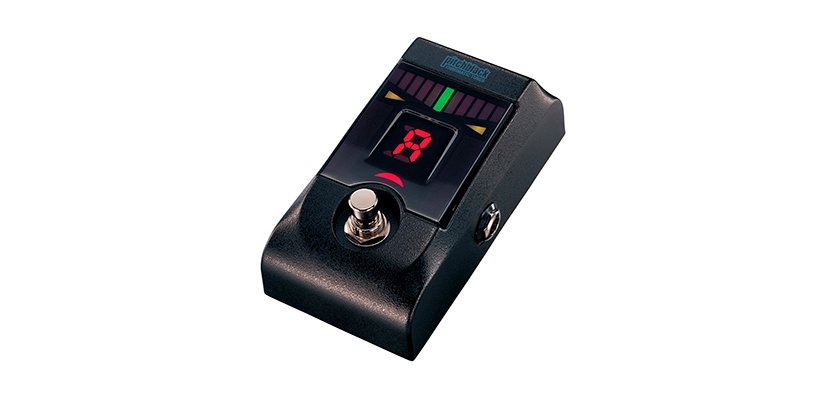
The Korg guitar tuner is a pedal tuner that has a rugged aluminum body frame that protects the device from damage. A large clear LED display with a light-emitting surface creates the conditions for easy operation in direct sunlight and in a darkened room. It’s equipped with a 9V DC input and output, from which you can supply power to other effect pedals using the optional network adapter. The pedal itself can be powered by the 9-Volt battery. The True Bypass with a passive pickup demonstrates really loud pop while switching from tuner to output. When switching optional cables, you can supply up to 200 mAh for several pedal effects, thereby reducing the number of network adapters required. This guitar tuner pedal provides adjustable calibration from 436Hz to 445Hz. Pay attention, that the warranty period is only 1 year.
Pros
- It mutes the input signal for noiseless tuning and when the tuning mode is turned off, the input signal passes directly to the output without any change.
- The unit demonstrates all notes, including sharp and flats.
- It has 4 display modes (Full Strobe, Half Strobe, Meter, and Mirror), all of which work decent and have their own peculiarities.
- The Pitchblack has a true bypass switch to be sure that the tone is unaffected.
Cons
- It can operate on battery only 5 hours that is not a good indicator comparing to other modern devices.
- It seems that polytune option doesn’t work well on all strings. Some are good, some are off by as much as a quarter tone.
Video Korg Pitchblack
Boss TU3
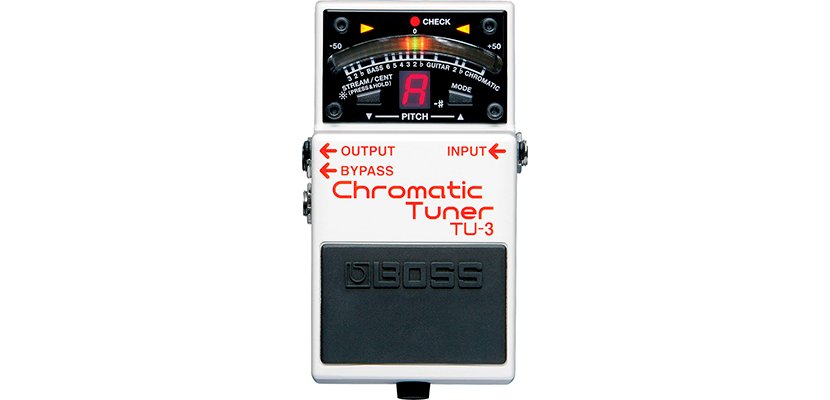
This is a tuner pedal with a regular footswitch. The Boss guitar tuner includes a note name indication, including supporting a 7-string guitar and 6-string bass guitars. Moreover, the flat tuning mode can low the pitch to 6 semitones down. The Accu-Pitch feature allows visually control the guitar settings and checks the state of its effects pedal. The unit gives power to 7 compact BOSS pedals. I really like that it can work both in chromatic mode and guitar, or bass tuning mode. The tuner comes with the 1 D battery, which is enough to work for 15 hours. However, you can purchase a power cord additionally and make it work via a standard power source. The TU3 has an input and two outputs. Perhaps, the Boss TU3 doesn’t belong to the best guitar tuners, but despite being a decent device, the manufacturer provides it with a 5-year warranty, which is a good term.
Pros
- The High Brightness mode increases the readability of the indicator under the bright sunlight.
- There is a possibility to adjust the brightness of the display.
- There’s an auto-shutdown of the tuner in order to save energy.
- The True Bypass output makes it possible to get the silent tuning option.
Cons
- Sometimes it displays nothing and then jumping notes appear. I have to restart the device.
- Some strings appeared to be untuned even after its adjusting performing, so I have to do it again.
Video Boss TU3
BOSS TU-12EX

The TU-12EX provides automatic hands-free chromatic tuning over eight full octaves. The unit contains two types of input and output jacks: line and built-in microphone. Its user can easily plug a guitar or bass into the line input or simply point the microphone at your acoustic guitar/another instrument without a pickup. There’s an Accu-Pitch function beeps when the string reaches the required note. This feature can be turned off (by turning the silent mode on) when adjusting on the stage (if the beep is annoying). It also provides an automatic shutdown feature at idle mode that saves battery power. The BOSS TU-12EX requires 3 AAA batteries, which permits the unit to work while continuous usage for 15 hours, moreover, the device can also be powered via AC adapter.
Pros
- The built-in tuner microphone allows you to tune even the acoustic guitar.
- It has an LED indicator and an indicator in the form of a “needle”, enabling you to tune the instrument quickly and accurately.
- The BOSS TU-12EX is a guitar tuner with Flat Tuning mode that allows you to tune in a standard system, as well as in a low system (up to 6 half steps down).
Cons
- The process of picking the notes up isn’t that accurate in chromatic mode.
- The assembling quality isn’t good as the body frame has some scratches on it and buttons are a little bit loosen.
Video BOSS TU-12EX
TC Electronic PolyTune Clip
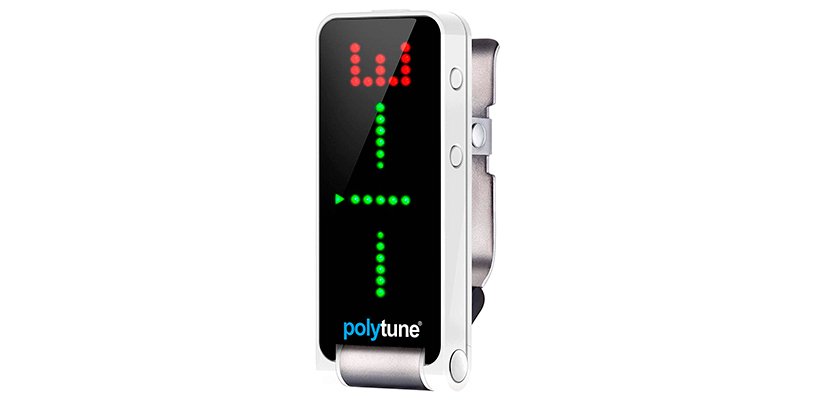
This clip-on guitar tuner has an adaptive screen (LED Matrix Display), which can be placed almost in any position (for left-handers and right-handers). Its steel clothespin is securely attached to the headstock and the coating does not scratch the tool. The TC Electronic PolyTune Clip belongs to the cross-functional acoustic guitar tuners that can be also used for bass, electric, or acoustic guitar, and even violin (for items with max 6 strings). If you will hit not 1 string, but 6 at the same time, the PolyTune Clip immediately switches from monophonic to polyphonic mode (automatic detection for single or poly note tuning), showing you how tuned all 6 strings are even while playing chords. The tuner can turn off itself in 3 minutes after turning it on (regardless of whether you use it or not), such a feature helps save the battery life. On the backside, there is a tight-fitting battery compartment, which can be opened without the help of additional devices. The manufacturer provides the unit with 3 years warranty and a bonus computer tuning plugin.
Pros
- When placing the instrument in a case, the tuner remains in its place without causing any inconvenience to the musician with its storage and transportation.
- The tuner has a large, color, ultra-bright display on which the taken note and the process of its tuning are displayed.
- It’s amended by one lithium-ion coin battery that can work up to 18 hours.
Cons
- The unit is made of plastic that has a chemical smell.
- The screen is sensitive and even slight scratches are clearly visible on it.
Video TC Electronic PolyTune Clip
Snark SN-5
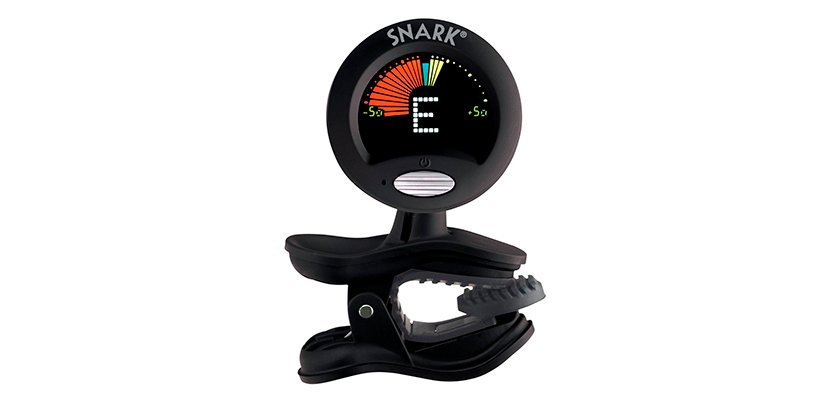
This chromatic clip-on Snark guitar tuner for guitar, bass, and violin reads vibrations, has a bright display that easily rotates 360 degrees for comfortable viewing and back arm that can be easily regulated. The device can be tuned in noise surrounding; moreover, it’s possible to switch between various tunings via a few movements (even in the middle of the song). You can get a precise tuning (+/- 0 cents) and the required sound without any efforts (the manual contains all the useful recommendations on unit adjusting). One lithium metal 2032 battery can last for 1 month and you have to take care of its power because the tuning accuracy directly depends on the battery charging level. The Snark SN-5 is a good variant even for ukulele and 12-string acoustic guitars. This device is much better than the iPhone App, as the result is more accurate and takes less time.
Pros
- There’s no need to use cords with the Snark SN 5, even while working with the electric or bass guitars.
- The activation can be started by one button pressing.
- Auto Shutoff feature saves the battery energy.
- It reads sounds from your guitar and does not pick up other strains from the surrounding (due to the vibration).
Cons
- It works only if attached to the headstock. If you will hold it in hands or put next to the guitar, it will not catch the vibration.
- The battery clip is fragile and the ball joints can be easily broken.
Video Snark SN-5
TC Electronic PolyTune 3
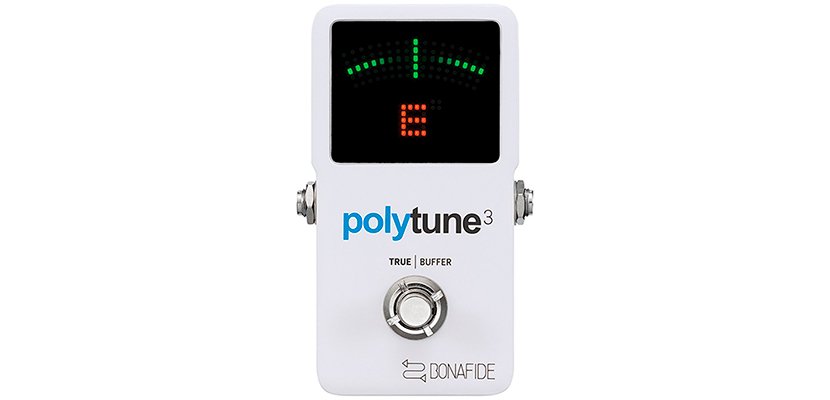
Its case is well assembled, all the elements are tightly fitted to each other, nothing creaks, and does not hang out both outside and inside the tuner. There is a display with an LED on the top panel that is protected by special glass. Information on the screen is read without problems: the elements are bright and large, clearly distinguishable in any lighting conditions. The TC Electronic gives a 3-year warranty on the display itself and the protective glass. There’s a special Bonafide Buffer that allows a lossless signal to pass through cables of any length and eliminates the need to turn off the tuner after each tuning. There’s no need to purchase additional pedal due to the integrated buffer pedal presence, as you can simply plug in a supplementary output and power up one more pedal. This bass guitar tuner can work in 3 modes: polyphonic, chromatic, and strobe. The last one is designed for extremely precise tuning of instruments with an accuracy of +/-0.02 cents. Polyphonic and chromatic tuning modes supply tuning accuracy of up to +/-0.5 cents. I really like that the TC Electronic PolyTune 3 simply takes a copy of the audio signal to the buffer, where it works with it without any delays, distortions, or limitations in the tuner functionality.
Pros
- The display is easy to understand. The tuned strings turn green, the untuned ones turn red, and that is comfortable for the guitarist’s perception.
- Polyphonic tuning allows the guitarist to tune all the strings of the guitar or bass simultaneously, while the tuner can automatically determine how the guitarist tunes the instrument.
- The function of a magnetic needle imitating demonstrates when the digital pointer approaches the center and makes its movement smoother for greater accuracy.
- This pedal allows strumming all six strings simultaneously.
Cons
- There are some troubles with the sensitivity on the lower strings. It depends on many factors and a type of guitar.
- The polyphonic mode isn’t that accurate because the display shows only a couple of divisions higher and lower, so it is not always clear how much the string is untuned.
- The strobe tuning requires high concentration and it isn’t easy.
- As this tuner comes as a pedal, it occupies a place on your pedalboard, while other tuners can be attached to a headstock, for example.
Video TC Electronic PolyTune 3
ROADIE 2
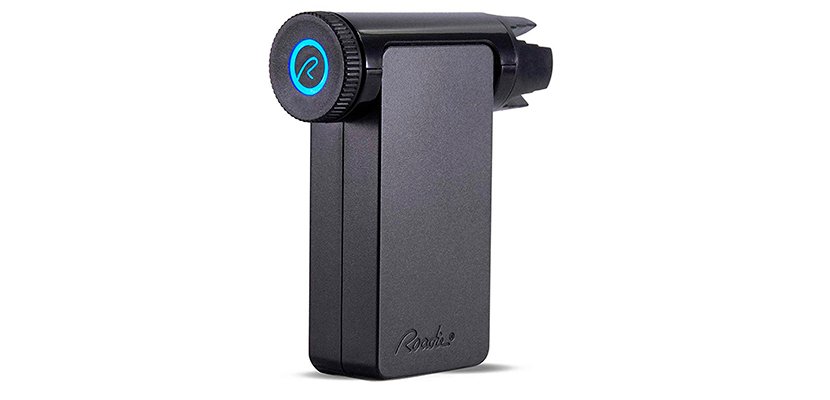
The clip-on Roadie 2 guitar tuner is completely autonomous and uses vibration detection to tune even in a noisy environment. It can be called as 6-, 7-, 12-string guitar tuner, as it’s compatible even with ukulele, mandolin, banjo, and more. It can be used by itself out of the box or cooperate with a special app that contains a Detect Mode, which recognizes the notes and saves the tuning for the player. The device itself is a clip-on with a display on it. The wheel is used to scroll through the menu items to select the tools, settings, and features displayed on the OLED screen at the top. The power button is also used to confirm the option and is perceived as a visual aid during the tuning process (the backlight changes from light-blue to bright green when it’s finished (there also will appear a beep sound)). It takes nearly 30 seconds to perform all the tuning or change its adjusting. It’s useful that Band Industries has added LED backlighting to the front of the device, which can be activated during tuning in low light so that the player doesn’t have to perform all the adjusting procedures in the dark. The unit is supplemented by the 1-year warranty. The battery can last for 1 month in the case of infrequent use.
Pros
- The Roadie 2 Li-ion battery charges with a modern USB-C cable that is rather useful.
- There are 20 preset adjustments, which makes it possible to create your own aligning.
- The matte black plastic Roadie 2 body frame is slightly thinner than its predecessor.
Cons
- The unit is navigated via a small wheel in the side on the body frame that is loose and refuses to click into the required position.
- Many LED modes are not mentioned in the manual, so it’s hard to find out their purpose.
Video ROADIE 2
Hipshot GT2
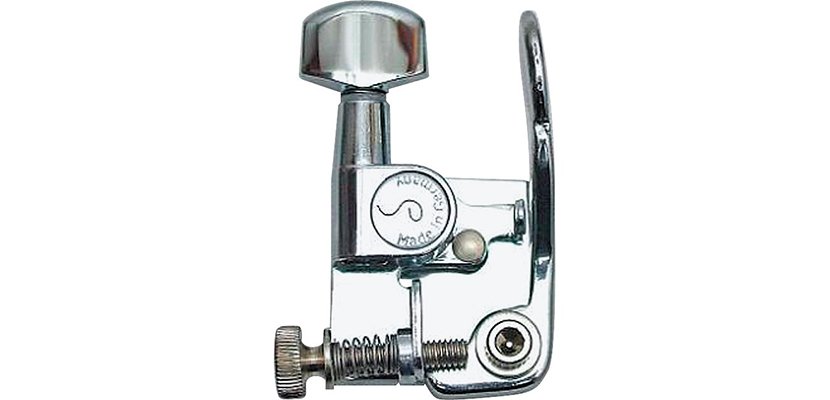
This clip-on unit drops your E to D (or even to C) via the dab of a lever. The accessory has a solid construction and stays remain even after falling from the height. It won’t fit the acoustic guitar as the Hipshot GT2 can be regarded as an accessory for a Fender style electric guitar. The installation manual doesn’t contain all the useful information and I have to watch the whole installation and usage process via YouTube. It can fit the 68 Telecaster but only with some modifications. This refers to one screw hole making in order to hold the hipshot plate in its place. As the 68 has small vintage tuners, it’s better to ream the tuner hole on your headstock for this to fit. Maybe this unit isn’t the best guitar tuner, but it’s perceived as a decent classic variant for those ones, who prefer only time-proved accessories.
Pros
- I like that this guitar tuner makes the switching from standard to drop-D or back in a few seconds.
- It can be used with the Double Stop system in order to get the whole list of tunings.
- This accessory is the classic one, so you don’t need to worry about battery draining. It works without any limits.
Cons
- You need to drill an additional hole to accommodate the mounting screw.
- If the guitarist is in a cold room or has changed the strings, the calibration has to be performed one more time.
Video Hipshot GT2
Buyer’s Guide
What Type of Guitar Tuning do You Need?
Before answering this question, you have to get acquainted with the most widespread types, choose an interesting option that meets your demands and will be comfortable for personal usage.
Handheld
Such guitar tuners do not have special mounts; they are simply laid on a suitable surface for further adjusting. Handheld tuners usually have a 1/4” jack for guitar plugging and an inbuilt microphone. These devices can display 6 notes and be used for classic guitar tuning or can be perceived as full-blown chromatic tuners that are able to work with 12 chromatic pitches. The device is a good choice for simultaneous instruments tuning by a certain group of musicians. Some models can combine the functions of a tuner and a metronome.
Strobe
They are also called “pocket” tuners due to their small size. Strobe tuners determine the frequency of the sound wave and compare it with the reference value of the corresponding note. These units can be connected to the guitar via a regular jack. Strobe tuning historically used a disk. There were special slots that created the stroboscopic effect as it could spin at really high speed. Today’s stroboscopic tuners use an LED array strobe, which allows getting the same results without mechanical movements performing.
Pedal
Pedal tuners are a modernized analog of stroboscopic tuners. The principle of operation is the same, but in addition to the input jack for an instrument connection, they have an output jack for the junction to an amplifier, processor, etc. This is very convenient since it does not require the equipment decommutation for tuning the guitar. Floor tuners are designed to be conveniently placed on the floor and controlled with the footswitch. They have a sturdy case, the on/switch button is made in the form of a pedal; the indication is bright and large enough for the convenience of playing standing.
Clip-On
The tuner is fastened to the instrument with a special clip. In the case of a guitar, it is usually attached to the headstock. The sound of the instrument is recorded via a piezoelectric sensor, due to which such units are resistant to ambient noise. In addition to the piezoelectric sensor, a microphone is sometimes integrated with it. Some tuners rotate relative to the mount that makes the display clearly visible. This device is suitable for both acoustic and electric guitars. The advantages of these tuner-clothespins are small weight and size, ease of use at home, at rehearsals, or at concerts.
Rackmount
These units can be probably called the best guitar tuners for musicians and sound engineers who use mostly rack equipment. Such tuners are large, which means they allow you to use more sophisticated electronics, big display, and many additional features. It can be complemented with different tuning modes and is capable of being set with a metronome. In addition, such tuners are good for recording studios, as they have several inputs and outputs and can be built into complex switching schemes.
Soundhole
These tuners have a built-in microphone. They are placed inside the guitar’s hole (units are invisible for other people, but not you). There’s a special built-in piezo sensor, which recognizes the pitch of the musical unit. Among the advantages of acoustic tuners, it can be noted the versatility, since they can be used to tune almost any instrument and at the same time do not require special connections and special skills.
App
Such guitar tuners allow you to customize the instrument due to the microphone of your gadget and the corresponding application. Of course, this type of tuner is available, but there are many complaints about the accuracy of this setting since the inbuilt microphone is not always able to accurately capture the sound. It’s easy to operate this app as the user has just to follow the recommendations and place the guitar as close to the smartphone as possible. Pay attention that such apps are used at home or in the studio because it might be hard to tune the guitar on stage quickly.

Hi everyone! I’m Thomas Moody, also known as Guitarzan.
